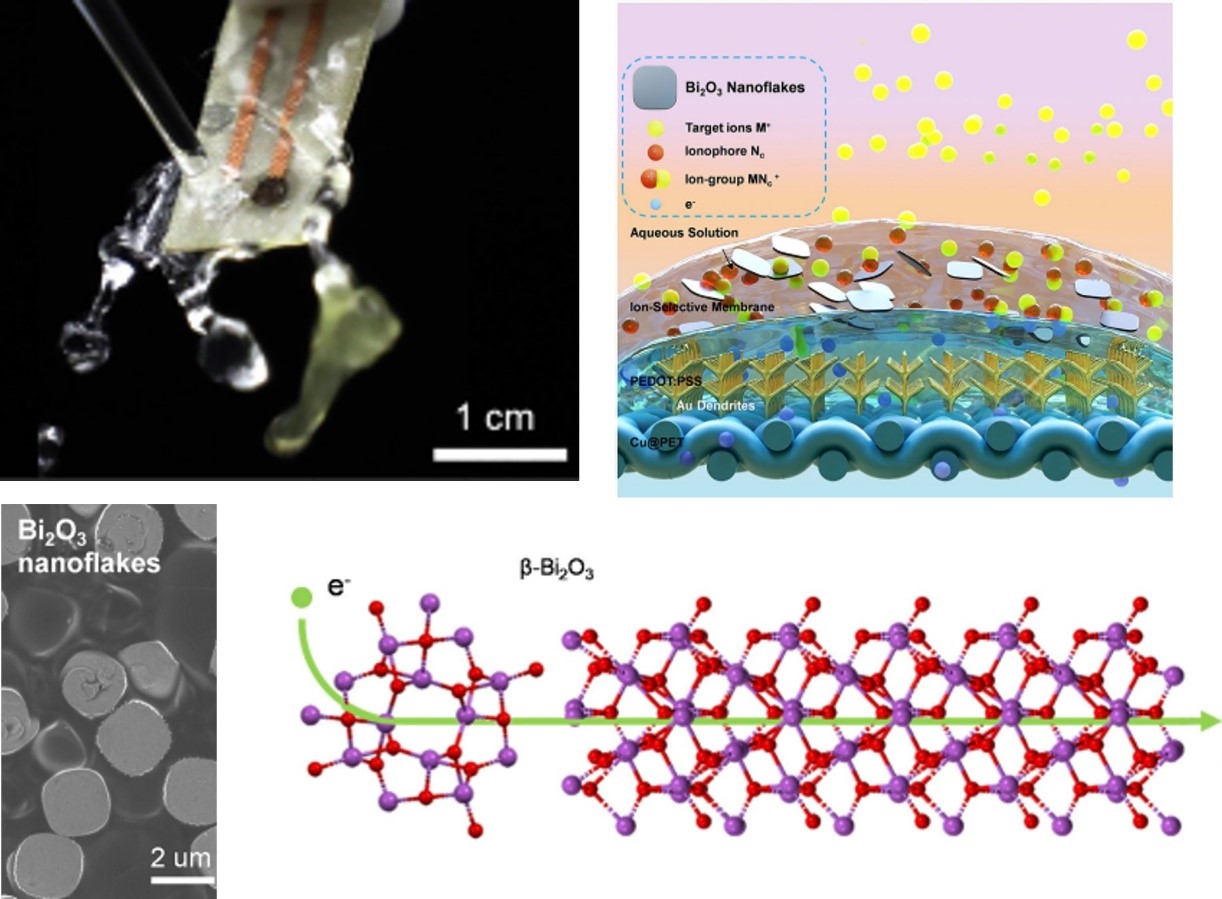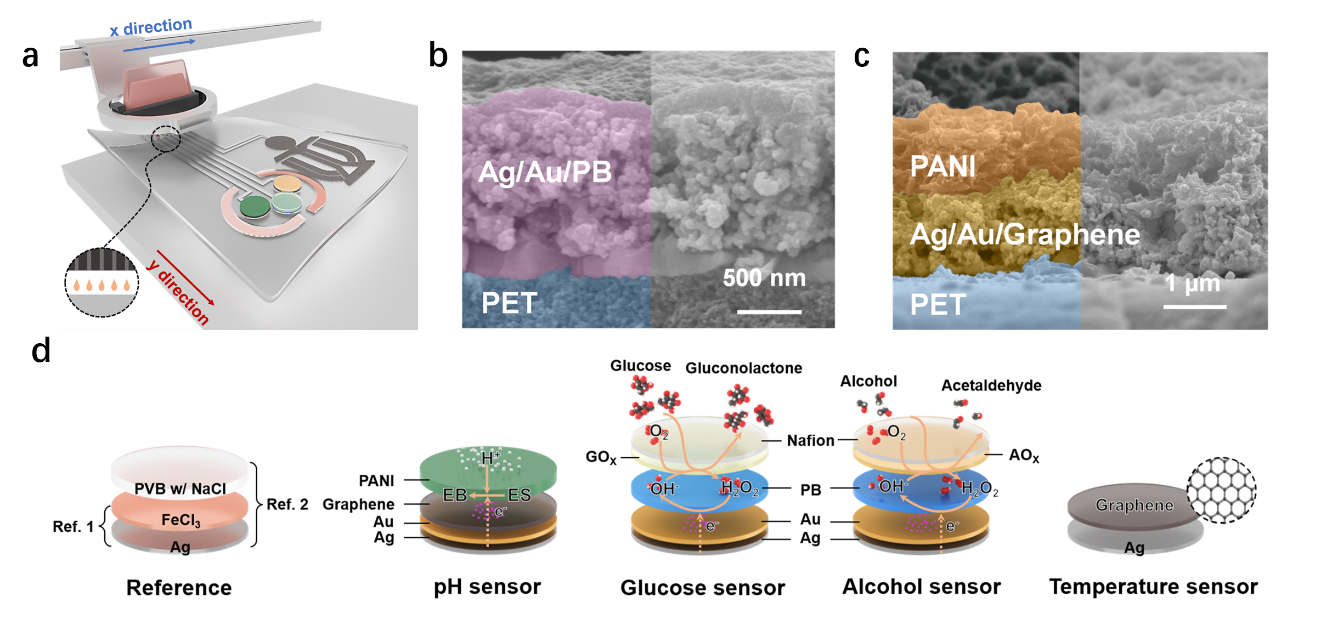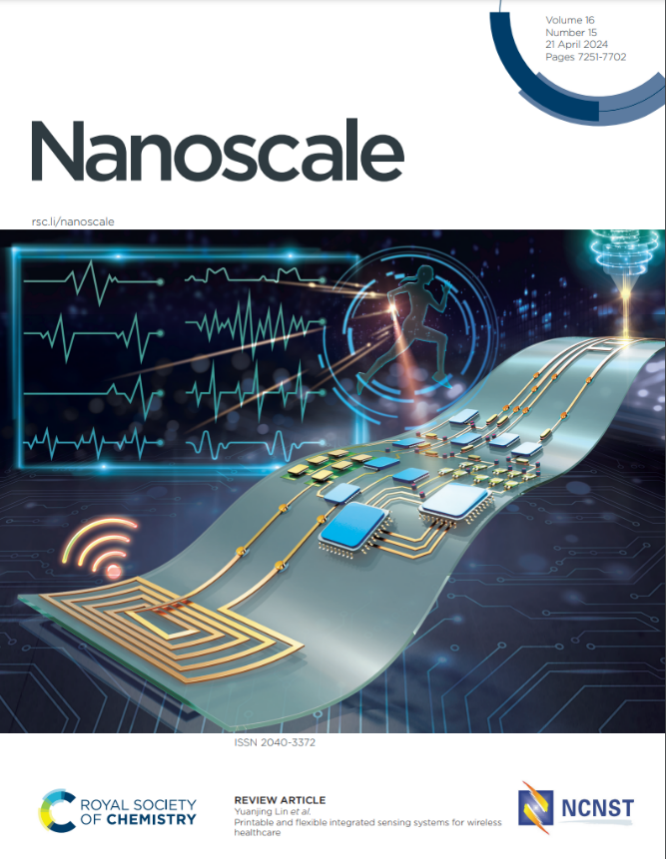Electrochemical biosensors have emerged as promising tools for tracking human physiological dynamics through non-invasive sweat analysis. However, integrating multiple sensors in a highly controllable manner on flexible substrates for long-term and reliable biosensing remains a key challenge.
The research group of Professor Yuanjing Lin from the Southern University of Science and Technology (SUSTech), in collaboration with Professor Zijian Zheng from The Hong Kong Polytechnic University (PolyU) and Professor Zhiyong Fan from The Hong Kong University of Science and Technology (HKUST), has published a series of papers that highlight innovative approaches in the design, integration, and application of flexible biosensors for advanced health monitoring systems.

Advancing washable sensors for reliable sweat monitoring
Electronic textiles, with their excellent comfort, breathability, and flexibility, show broad application prospects in health monitoring and sports tracking. Yet, the development of highly sensitive and reusable textile-based biosensors still faces numerous technical hurdles. Traditional wearable biosensors often rely on rigid materials or encapsulation to protect sensors from environmental influences, which often leads to poor breathability, low comfort, and bulky size. These sensors are also prone to functional loss during the washing process, especially when worn for extended periods, and require frequent cleaning, making their durability and stability difficult to ensure.
To address the issue of washability in electrochemical sensors, the researchers developed a washable ion-selective sensor by innovatively depositing β-Bi₂O₃ nanosheets, known for their fast ion transport characteristics, onto the ion-selective layer. This not only significantly enhanced the sensor’s ion conduction efficiency but also greatly improved its resistance to mechanical disturbances and washing (Figure 1).
The introduction of β-Bi₂O₃ nanosheets ensures that the sensor maintains high sensitivity and reliability even after multiple washes, effectively overcoming the stability shortcomings of previous technologies. The various washable sensors developed (including those for sodium, potassium, and pH) can accurately monitor low concentrations of biomarkers in sweat. Remarkably, even after up to 20 washes, the performance retention rate of its sodium-ion sensor remains over 90%; it exhibits a sensitive response of 58.70 mV/dec, with signal drift controlled within 3.85 mV/h during continuous 2.5-hour sweat monitoring. This achievement paves a new path for the widespread application of textile-based wearable devices and provides more reliable and practical solutions for mobile health monitoring and telemedicine.
These results were published in the journal Device under the title “Washable textile biosensors enabled by nanostructured oxides with fast ion diffusion”.
Joint Ph.D. student Yuqing Shi of SUSTech and PolyU is the first author of the paper. Assistant Professor Yuanjing Lin and Professor Zijian Zheng are the co-corresponding authors, with SUSTech serving as the first affiliated institution.

Figure 1. Washable ion-selective sensors modified with β-Bi₂O₃ nanosheets
Innovating high-resolution in-texiles electrodes for flexible electronics
In response to the challenge of achieving high-precision electrode fabrication and high-density device integration on porous structured textiles, the collaborative team employed a combined polymer-assisted metal deposition and double-sided photolithography. This approach enables the monolithic integration of a wireless sensing system directly onto porous textiles (Figure 2). This method achieved a textile electrode fabrication precision of 100 micrometers, with excellent conductivity, mechanical stability, as well as retained washability and breathability of the textile.
This innovative method allows for the integration of multi-layer electronic devices into textiles (e.g., double-sided temperature sensors), as well as a fully textile-integrated sweat-sensing headband capable of real-time wireless monitoring of glucose, lactate, and electrolyte ions. This demonstrates its broad application potential in medical monitoring, health tracking, and personalized medical devices. The research provides new ideas for the construction of flexible integrated systems.
These results were published in the prestigious journal Nature Communications under the title “Well-defined in-textile photolithography towards permeable textile electronics”. It was also selected as a featured article in the Editors’ Highlights section of the journal.
Joint Ph.D. student Xiaohao Ma of SUSTech and PolyU is the co-first author of the paper. Professor Zijian Zheng, Assistant Professor Yuanjing Lin, and Assistant Professor Huang Qiyue from PolyU are the co-corresponding authors.

Figure 2. High-precision textile internal lithography method for high-performance, multimodal integrated electronic textiles
Fully inkjet-printed wearable systems for enhanced biosensing
In their efforts to advance the fabrication of flexible sensor devices and systems on thin-film substrates, the research group, in collaboration with Professor Zhiyong Fan’s team from HKUST, developed a fully inkjet-printed wearable, flexible integrated system, achieving ultra-sensitive and stable multimodal biosensing arrays (Figure 3).
Through systematic research on printable ink formulations and manufacturing processes, the team optimized composite inks made from synthesized micro-nano materials, including Ag, Au, PB, PANI, Graphene, GOX, AOX, PVB, Nafion, and UV epoxy inks. These formulations were refined to meet the requirements for surface tension and viscosity in inkjet printing. The droplet-assisted process during inkjet printing allowed for the creation of seamless and uniform interpenetrating interfaces between layers, thereby greatly improving the mechanical stability and electronic transmission between the sensor’s functional material layers.
The prepared printable glucose and alcohol sensors demonstrated sensitivities of 313.28 µA mM⁻¹ cm⁻² and 0.87 µA mM⁻¹ cm⁻², respectively, and achieved continuous sweat monitoring for up to 30 hours, which is one of the best performances of enzyme-based sensors based on inkjet printing. In addition, the introduction of pH and temperature calibration in the sensing array improved the accuracy of low-concentration physiological component analysis. This fully printed manufacturing strategy for wearable integrated biosensing systems provides new ideas for the controllable fabrication of flexible multimodal sensors.
These results were published in Advanced Materials under the title “Ultra-Sensitive and Stable Multiplexed Biosensors Array in Fully Printed and Integrated Platforms for Reliable Perspiration Analysis”.
Joint Ph.D. student Suman Ma of SUSTech and HKUST is the first author of the paper. Assistant Professor Yuanjing Lin and Professor Zhiyong Fan are the co-corresponding authors.

Figure 3. High-sensitivity, high-stability fully printed biosensing array for multimodal sweat analysis
The future of printable and flexible biosensing for healthcare
The research group was invited to publish a review article that systematically explores the progress of printable, flexible integrated sensing systems for wireless health monitoring. The review discusses the synthesis and construction strategies of micro-nano materials and devices, and summarizes the application prospects and challenges of achieving high compatibility, low cost, and large-scale multifunctional electronic device fabrication and system integration technology.
The article was published in Nanoscale, a high-impact international journal in nanoscience and nanotechnology, under the title “Printable and flexible integrated sensing systems for wireless healthcare”. It was also selected as the cover article for this volumn of the journal.
Ph.D. student Kemeng Zhou and undergraduate student Ruochen Ding (now a Ph.D. student at HKUST) from SUSTech are the co-first authors of the article, with Professor Yuanjing Lin serving as the corresponding author. Additionally, Professor Lin was shortlisted as one of the 2024 Nanoscale Emerging Investigators.

Figure 4. The cover of Nanoscale featuring the review article by Professor Yuanjing Lin’s research group
Paper links (In order of appearance above):
Device: https://www.cell.com/device/fulltext/S2666-9986(24)00399-5
Nature Communications: https://www.nature.com/articles/s41467-024-45287-y
Advanced Materials: https://onlinelibrary.wiley.com/doi/full/10.1002/adma.202311106
Nanoscale: https://pubs.rsc.org/en/content/articlelanding/2024/nr/d3nr06099c
To read all stories about SUSTech science, subscribe to the monthly SUSTech Newsletter.
Proofread ByAdrian Cremin, Yingying XIA
Photo By